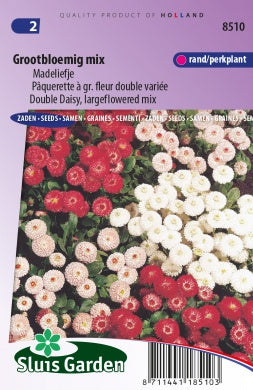1
/
of
1
Double Daisy large flowered mix
Double Daisy large flowered mix
Regular price
1.350 KWD
Regular price
Sale price
1.350 KWD
Unit price
/
per
Shipping calculated at checkout.
Couldn't load pickup availability
Growing Double Daisy Large Flowered Mix (Bellis perennis) involves providing the right conditions for this variety to thrive. Here's a general guide on how to grow Double Daisy Large Flowered Mix:
**1. Planting Time:**
- Sow seeds indoors 6-8 weeks before the last expected frost in your area.
- Alternatively, direct sow seeds outdoors in early spring or late summer.
**2. Soil Preparation:**
- Choose well-draining soil enriched with organic matter.
- Aim for a slightly acidic to neutral pH (around 6.0 to 7.0).
**3. Sowing Seeds:**
- Scatter the seeds on the soil surface and gently press them down. Since these seeds need light for germination, do not cover them with soil.
- Keep the soil consistently moist until germination occurs.
**4. Sunlight:**
- Double Daisies prefer full sun to partial shade.
**5. Transplanting:**
- Transplant seedlings outdoors after the danger of frost has passed and they are large enough to handle.
- Space the plants according to the recommendations on the seed packet.
**6. Watering:**
- Keep the soil consistently moist, especially during dry periods. Water at the base of the plants to prevent fungal issues.
**7. Fertilizing:**
- Use a balanced, all-purpose fertilizer when transplanting seedlings.
- After that, periodic feeding may be beneficial, but be cautious not to over-fertilize.
**8. Mulching:**
- Apply a layer of mulch around the plants to help retain moisture and suppress weeds.
**9. Deadheading:**
- Remove spent flowers regularly to encourage continuous blooming.
**10. Pruning:**
- Pinch back the growing tips when the plants are young to encourage bushier growth.
- You may also pinch back spent flowers to promote more blooms.
**11. Protection from Frost:**
- Provide protection if frost is expected. Double Daisies are generally hardy, but extreme cold can affect them.
**12. Pests and Diseases:**
- Monitor for pests such as aphids and spider mites. Use insecticidal soap or neem oil as needed.
- Double Daisies are generally resistant to diseases, but good garden hygiene is essential.
**13. Container Growing:**
- Double Daisies can be grown in containers. Ensure the pots have drainage holes, and use a well-draining potting mix.
**14. Overwintering:**
- In colder climates, Double Daisies may not survive the winter outdoors. Consider growing them as annuals or overwinter them indoors if you have the space and proper conditions.
Double Daisy Large Flowered Mix adds charming and colorful blooms to your garden. Adjust care based on your specific growing conditions and local climate.
**1. Planting Time:**
- Sow seeds indoors 6-8 weeks before the last expected frost in your area.
- Alternatively, direct sow seeds outdoors in early spring or late summer.
**2. Soil Preparation:**
- Choose well-draining soil enriched with organic matter.
- Aim for a slightly acidic to neutral pH (around 6.0 to 7.0).
**3. Sowing Seeds:**
- Scatter the seeds on the soil surface and gently press them down. Since these seeds need light for germination, do not cover them with soil.
- Keep the soil consistently moist until germination occurs.
**4. Sunlight:**
- Double Daisies prefer full sun to partial shade.
**5. Transplanting:**
- Transplant seedlings outdoors after the danger of frost has passed and they are large enough to handle.
- Space the plants according to the recommendations on the seed packet.
**6. Watering:**
- Keep the soil consistently moist, especially during dry periods. Water at the base of the plants to prevent fungal issues.
**7. Fertilizing:**
- Use a balanced, all-purpose fertilizer when transplanting seedlings.
- After that, periodic feeding may be beneficial, but be cautious not to over-fertilize.
**8. Mulching:**
- Apply a layer of mulch around the plants to help retain moisture and suppress weeds.
**9. Deadheading:**
- Remove spent flowers regularly to encourage continuous blooming.
**10. Pruning:**
- Pinch back the growing tips when the plants are young to encourage bushier growth.
- You may also pinch back spent flowers to promote more blooms.
**11. Protection from Frost:**
- Provide protection if frost is expected. Double Daisies are generally hardy, but extreme cold can affect them.
**12. Pests and Diseases:**
- Monitor for pests such as aphids and spider mites. Use insecticidal soap or neem oil as needed.
- Double Daisies are generally resistant to diseases, but good garden hygiene is essential.
**13. Container Growing:**
- Double Daisies can be grown in containers. Ensure the pots have drainage holes, and use a well-draining potting mix.
**14. Overwintering:**
- In colder climates, Double Daisies may not survive the winter outdoors. Consider growing them as annuals or overwinter them indoors if you have the space and proper conditions.
Double Daisy Large Flowered Mix adds charming and colorful blooms to your garden. Adjust care based on your specific growing conditions and local climate.
Share

